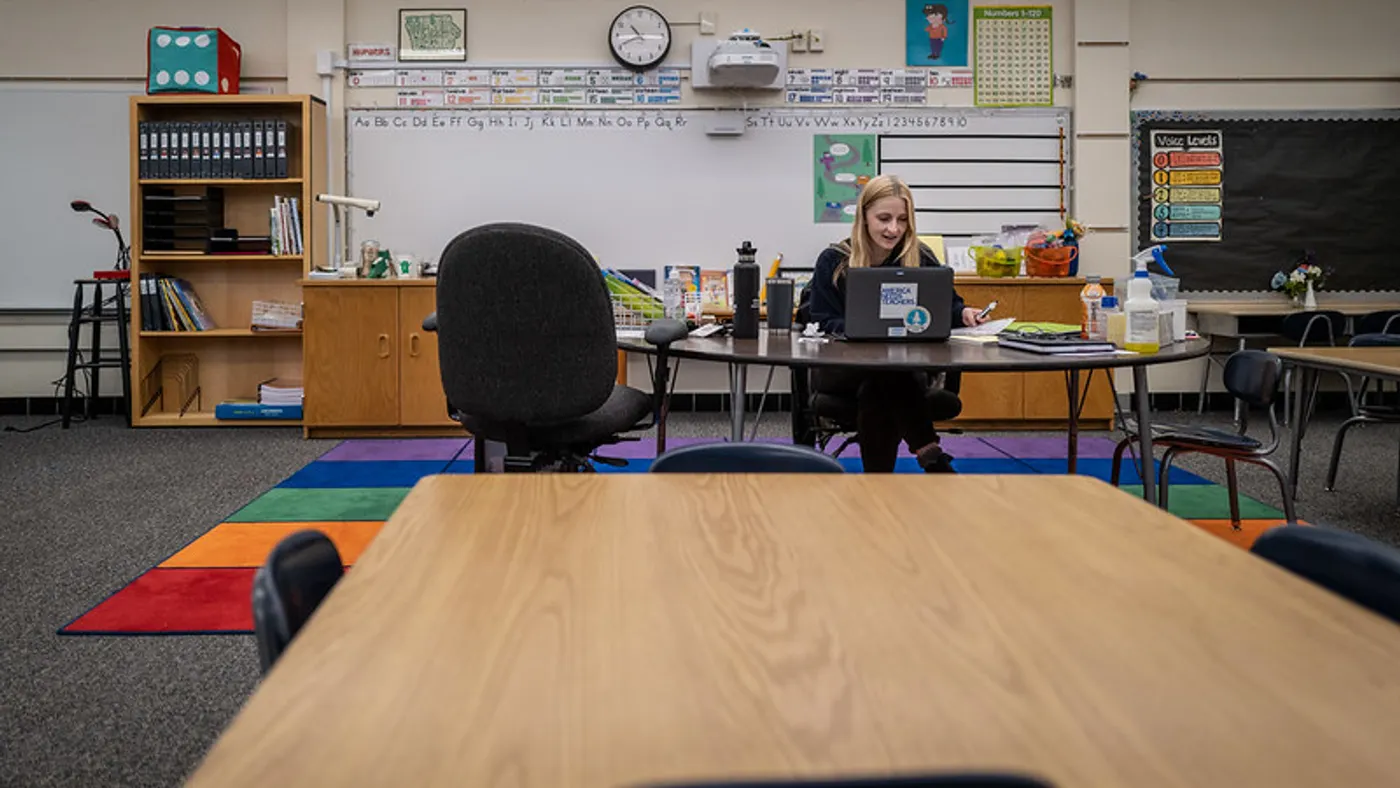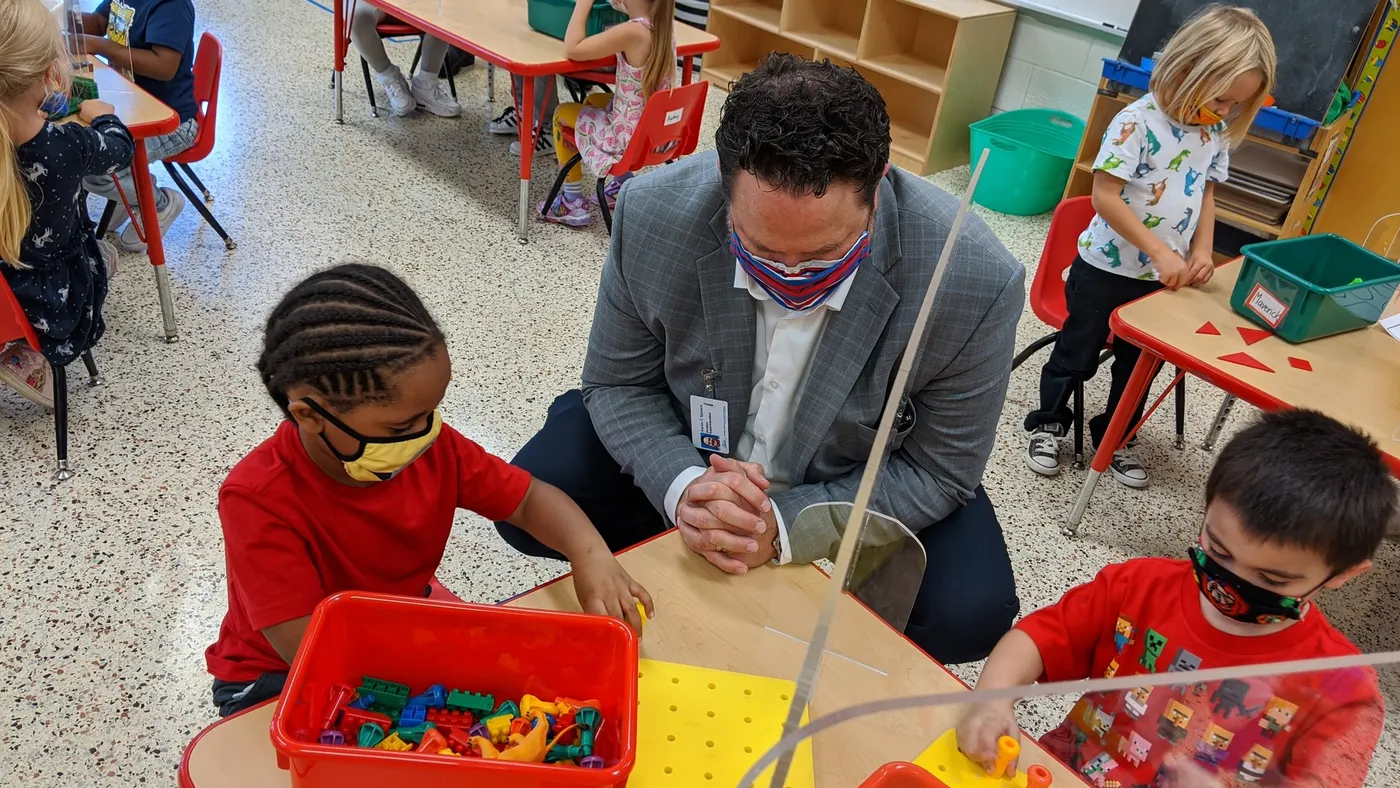
These 8 trends will impact schools in 2021
In the wake of an unprecedented and unpredictable 2020, the novel coronavirus pandemic has reshaped the K-12 landscape, shifting — and in some cases outright derailing — the trends guiding what 21st century education looks like.
The nation's public education system was forced to shift almost entirely to a virtual model overnight, catalyzing debates over the future of assessment, teacher burnout, recruitment and retention, online learning and more. At the same time, a dual crisis emerged as the nation confronted the role of systemic racism across society in the wake of the police-involved deaths of Black Americans.
With the effects of these crises likely to linger at all levels of school districts for years to come, these eight trends will be critical to watch in the coming year.
Vaccine navigation
As COVID-19 vaccines become readily available, teachers are potentially in the second phase of distribution, after frontline healthcare workers and long-term care residents, according to the Centers for Disease Control and Prevention. However, whether states and districts will require school employees to get vaccinated is unclear, and leaders have expressed concern about vaccine mistrust among the public.
Dan Domenech, executive director of AASA, The School Superintendents Association, previously told K-12 Dive he expects resistance and legal challenges to vaccinations in some places, but that the majority of districts may mandate them.
Vaccine mandates and exceptions could vary by state and locality. Even for traditional student vaccinations, 45 states and the District of Columbia grant religious exemptions to vaccine requirements with some variation in implementation. (There is no COVID-19 vaccine authorized for children under 16 years old.)
David L. Barron, a Texas lawyer in labor and employment law, told our sister publication HR Dive school districts can look to older federal guidance for some direction. For example, the U.S. Equal Employment Opportunity Commission's 2009 guidance on pandemic preparedness and the Americans with Disabilities Act stated an employer covered by the ADA may not compel all employees to receive an influenza vaccine regardless of their medical conditions or religious beliefs. The guidance was released during the H1N1 influenza pandemic and updated this year during the COVID-19 pandemic.
COVID-19 relief and Biden administration policy shifts
Prior to the second stimulus package's passage in Congress and signing into law by President Donald Trump Dec. 27, superintendents, advocacy organizations, associations and unions expressed the need for everything from targeted E-rate funding to greater meal flexibilities to more PPE funding in 2021.
Some believe the relief amount included for K-12 schools won't be enough to cover schools from budget cuts.
With an administration change right around the corner, Mike Petrilli, president of the Thomas B. Fordham Institute, a right-leaning think tank, told K-12 Dive the Biden administration may try to pass significant agenda policy items, like teacher pay and Title I funding increases, through a separate COVID-19 relief bill.
Considering Biden, a Democrat, may be working with a Republican-majority in the Senate, the incoming president may not be able to carry out his agenda items "as boldly as he would have liked," Petrilli said. (The Senate's makeup will be determined with a January runoff in Georgia.)
But still, Petrilli and others said, Biden may be able to make headway increasing education spending.
Others are eager to see what Biden may do in controversial areas like school choice. Some think a Biden administration may be bad news for those efforts, while others think the new president could be better for opening doors to "more constructive conversation around education reform again."
School models
Given the vast amount of resources expended last year to transition schools to a flexible virtual model, the pieces that worked well are likely here to stay — and those that didn't may still be ironed out for effectiveness.
While much attention was given to the challenges schools faced under the new model, a portion of students thrived in virtual environments. As a result of COVID-19 shutdowns, many districts now have the infrastructure to facilitate this option in the future, potentially helping traditional public education remain competitive.
That's just one piece of the evolving school model puzzle. In places where teachers with subject matter expertise previously were unavailable, districts now may be able to add classes in specialty or advanced subject areas for students with strong interests in subjects like computer science, thanks to the widespread use of virtual learning.
Before the pandemic, there was a growing call for a shift away from the industrial model of public education, where students in rows of desks are lead by an instructor, to one where they are spaced out in a flexible environment comparable to modern open offices while their teacher serves as more of a guide to their learning than a preacher of knowledge.
The pandemic has had a silver lining of further requiring schools to reconsider classroom design and the "when," "where" and "how" of learning. To what extent and how quickly these lessons drive the formation of K-12's next iteration is uncertain, but the table is set with significant opportunities for forward-thinking districts this year.
Assessments and accountability
While districts have resumed interim assessments, many are pushing to rethink them entirely for equity or other reasons. The U.S. Department of Education, which provided blanket waivers for state assessments required by ESSA for the 2019-20 school year, resumed assessment accountability this school year.
However, that decision has been met with mixed feelings.
Prior to the Education Department's announcement, lawmakers and states boards expressed the need to postpone state testing for the 2020-21 school year. When Georgia Gov. Brian P. Kemp and State School Superintendent Richard Woods jointly announced their decision to apply for suspension of standardized testing to the Department of Education, they said the decision was "in line with our longstanding shared belief that assessment has a place and a purpose in education, but the current high-stakes testing regime is excessive."
While the Education Department did not grant those requests, Education Secretary Betsy DeVos did encourage school leaders to consider the period a good opportunity to "rethink" assessments. And while testing experts don't foresee a successful push away from standardized testing, they do suggest schools look into detangling results from the high stakes attached to them, like teacher raises and student program placements.
In some places, district leaders are already talking with states, hoping to bring change to current assessment models.
Lost learning and social growth recovery
The disruption to learning and socialization due to the pandemic means as school life returns to normal as expected this year, educators will be pressured to help students recover essential skills. Indeed, this has already been a focus of many state and local school systems, principals and teachers, as well as parents.
How far students have fallen behind academically continues to be calculated, but data from the fall show concerning trends across the country. An initial analysis of NWEA MAP Growth assessments indicates dips in math performance, with students in grades 3-8 scoring between 5 and 10 percentile points lower than average compared to fall 2019.
School districts nationwide also are reporting more failing grades for the first semester of the 2020-21 school year. Fears of growing achievement gaps of vulnerable students, such as those who are English learners, from low-income families, students of color and students with disabilities, compared to their peers are fueling creative approaches to reach those most at risk for falling behind.
Responding to student trauma developed due to being separated from regular school life, the scariness of the novel coronavirus and the repercussions of the pandemic, such as job losses, illnesses and even deaths, will be an important factor in post-pandemic schooling, experts say.
Recruitment and retention of teachers and students
Despite school districts’ efforts to distribute devices and establish safe in-person learning spaces in order to continue teaching students during the pandemic, many districts reported a significant drop in student attendance at the beginning of the 2020-21 school year. Additionally, school systems are raising concerns about the depleting availability of quality teachers and other school personnel.
These dilemmas are perhaps some of the initial obstacles school districts will need to tackle as a regular school environment returns in 2021, as expected.
Early data suggests millions of students across the country missed a significant amount of school during the pandemic, according to a December 2020 report by Attendance Works. Enrolling and encouraging participation of students is already a mission at many school districts. Schools are assigning staff to keep in regular contact with each family and to help meet their unique needs. Schools are also offering classes in the evenings and weekends to provide flexibility to those unable to participate in weekday lessons.
The ability to offer personalized and rigorous lessons is also hampered by teacher shortages, including the lack of substitute teachers. When the National Education Association polled educators in 2020, it found 28% said the pandemic has made them more likely to retire early or leave the profession. The NEA poll also showed 43% of Black teachers say they’re now more likely to retire early or leave.
Certain incentives such as differentiating staffing models, providing leadership and professional development opportunities for staff and showing appreciation for school personnel could help with staffing woes but a comprehensive and collaborative approach to teacher recruitment and retainment is likely needed to help school systems recover from the damage COVID-19 has brought.
Teacher burnout
Teacher burnout has steadily increased in recent years amid the pressures of high-stakes accountability metrics, the rise of more demanding learning models like project-based learning, stagnant pay and the shouldering of much of the blame when policy and reform efforts don't pan out as hoped.
And then the COVID-19 pandemic ramped everything up.
Practically overnight, K-12 educators shifted to and adapted lessons for remote learning — a model they and their students were largely unfamiliar with. Figuring out how to do so effectively as concerns also grew for students' personal and academic needs took its toll. And as some schools nationwide reopened in varying degrees this fall, stressors grew as many teachers and staff remained concerned about potential health risks. Those in hybrid models also had to navigate teaching both virtually and in-person simultaneously.
The result: A National Education Association poll in August found 28% of teachers were likely to leave the profession or retire because of COVID-19, with one in five teachers with less than 10 years experience expressing this sentiment compared to 40% with 21 to 30 years of experience and 55% with more than 30 years. In an Illinois Education Association poll, more than a third of members said they have considered a career change, 76% said this year’s workload is “somewhat” or “much” heavier than last year, and 66% reported being more “burned out” than usual.
Addressing this issue will be critical to retain skilled and rising educators in the coming years.
Social justice and anti-racist practices
While some schools had laid a path to increase cultural responsiveness, the deaths last year of Breonna Taylor, George Floyd and Rayshard Brooks — all unarmed Black people who died at the hands of law enforcement — sparked a reckoning nationwide that placed schools in the forefront of the movement to quash racial prejudices and systemic bias.
That work will continue and grow stronger many school districts have promised. Those districts are making voluntary efforts to rewrite strategic plans, expand curriculums for diverse student bodies, integrate schools and put resources into professional development. Individual teachers and administrators also are taking proactive approaches to better understand how their words and actions can create inclusive classes and school cultures.
Derek McCoy, principal of North Asheboro Middle School in Asheboro, North Carolina, told K12 Dive in June: “What’s going on right now is a call for all of us to really make sure that we’re focused on teaching the right things.”
As schools emerge from the pandemic, educators will need to rethink how to distribute what could be limited resources for providing equitable student experiences. The challenges of rebuilding post-pandemic school systems, including teachers shortages, learning losses and trauma response, hopefully will not dilute progress toward equitable practices, say those educators, administrators and groups advocating for change.










